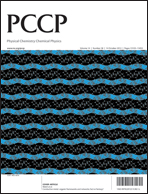A theoretical investigation of the interaction between small Pd particles and 1-butyl-3-methyl imidazolium ionic liquids with Cl−, BF4− and PF6− anions†
Abstract
Density functional calculations have been used to investigate the interaction between Pdn clusters (n = 1–6) and 1-butyl-3-methylimidazolium (Bmim+) based


 Please wait while we load your content...
Please wait while we load your content...